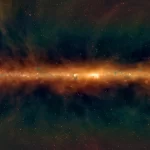Key Takeaways:
- Astronomers discover a colossal black hole in the Abell 1201 galaxy cluster, weighing 30 billion times the mass of the sun.
- Utilizing gravitational lensing, the team observed a background galaxy through the distortion created by the foreground’s massive black hole.
- This ultramassive black hole is notably inactive, differing from other large black holes known for emitting strong radiation.
- The discovery opens new avenues to study inactive black holes, shedding light on their evolution across cosmic time.
- This approach showcases the potential to detect numerous black holes beyond our local universe, providing insights into these enigmatic celestial entities.

In a breakthrough discovery, astronomers have unveiled an astronomical behemoth nestled within the Abell 1201 galaxy cluster: a colossal black hole towering at a mass equivalent to 30 billion suns. This ultramassive black hole has astounded scientists, marking a significant stride in understanding the extremities of these cosmic entities.
The revelation emerged from an innovative observation technique employing gravitational lensing. By harnessing the gravitational pull of a foreground galaxy, astronomers amplified the visibility of a background galaxy, enabling the detection of this gargantuan black hole. This technique acted as a celestial magnifying glass, revealing a vista that would otherwise remain distant and obscure.
Dr. James Nightingale, the lead author of the study from Durham University, emphasized the enormity of this find. Not only does it hover near the theoretical limit of black hole size, but its quiescent state challenges the conventional understanding of massive black holes, which often exhibit intense activity, emitting substantial radiation.
Employing meticulous analysis of Hubble Space Telescope images and advanced computer simulations, the research team meticulously calculated the extent of light bending around the foreground galaxy, pinpointing the colossal black hole’s mass. This pioneering methodology, previously unexplored, provided an avenue to scrutinize inactive black holes, a realm largely inaccessible through conventional observation methods.
The black hole’s dormancy, a rarity among its colossal counterparts, piques scientific curiosity. Unlike active black holes that blaze with emitted energy from matter consumed, this subdued entity promises a unique window into understanding the evolution of these enigmatic cosmic entities over vast cosmic timescales.
This groundbreaking discovery, detailed in the Monthly Notices of the Royal Astronomical Society, marks a turning point in astronomical exploration. It not only underscores the limits of black hole enormity but also unveils a novel approach to fathom the evolution and nature of these cosmic giants beyond the confines of our local universe.

